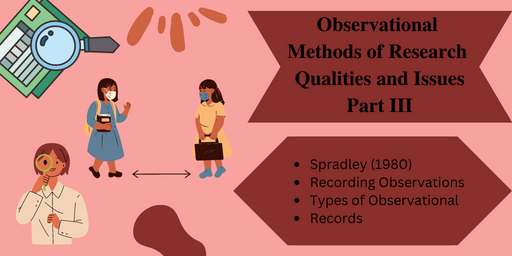Methods of Research and Gathering Observational Data (III): Observational research is a vital methodology used across various disciplines to gather in-depth insights into behaviors, interactions, and settings. By employing observational methods, researchers can capture the nuances of human behavior in natural contexts, providing valuable data that might not be accessible through other means. This discussion will explore different types of observational methods, the process of recording observations, and the various forms of observational records, referencing the framework established by Spradley (1980).
Observational Methods of Research
Observational methods can be categorized based on the level of participation of the researcher and the structure of the observations. These methods range from participant observation to structured observational studies.
Participant Observation
In participant observation, the researcher immerses themselves in the environment they are studying. This approach allows for a more holistic understanding of the context and the behaviors of participants. Participant observers typically maintain few restrictions on the nature of the data collected to minimize observer-imposed meanings.
The following aspects are considered crucial in participant observation:
- The Physical Setting: Understanding the physical environment where interactions take place is essential. Researchers examine the features of the setting, noting how it influences behavior. For instance, a well-organized classroom may promote more structured interactions among students.
- The Participants: Characteristics of the individuals being observed, such as their roles, demographics, and group dynamics, are critical. Researchers analyze who is involved and how their interactions contribute to the observed phenomena.
- Activities and Interactions: Observers focus on what participants are doing, saying, and how they communicate. This includes examining the progression of activities and the emotional tone of interactions.
- Frequency and Duration: Recording when activities start and end, as well as their recurrence, helps researchers understand the context of behaviors.
- Precipitating Factors: Understanding the reasons behind certain interactions provides deeper insights into the dynamics at play.
- Organization: Observers assess how interactions are structured and the norms governing behavior within the group.
- Intangible Factors: Observers should also be attentive to what is not happening or to discrepancies between verbal and non-verbal communication. This provides a fuller picture of the context.
Levels of Observation
Spradley (1980) describes three levels of observation that typically occur during fieldwork:
- Descriptive Observation: This initial level is broad and exploratory, allowing researchers to gather as much information as possible about the setting and participants. It helps formulate a foundational understanding.
- Focused Observation: After gaining insights from descriptive observations, researchers begin to concentrate on specific events or interactions that are pertinent to their research questions.
- Selective Observation: This final level involves highly focused observations aimed at facilitating comparisons between categories or activities. Researchers filter their observations to align with their analytical framework.
Recording Observations
Importance of Recording
While active participation and observation are crucial components of research, it is equally important to systematically record observational data. Memory alone is insufficient, as details can easily be forgotten or misinterpreted. Recording observations diligently and as soon as possible ensures the accuracy and reliability of the data.
Types of Observational Records
The methods used for recording observations can vary, but the most common forms include logs, field notes, photographs, and videotapes.
- Logs: Logs or field diaries serve as daily records of events and conversations observed in the field. They provide a historical account of the researcher’s activities and interactions. Logs are useful for planning purposes, tracking expenses, and reviewing completed work.
- Field Notes: Unlike logs, field notes are broader and more analytical. They go beyond mere documentation to include interpretations, insights, and syntheses of the data gathered. Field notes represent the participant observer’s ongoing effort to make sense of their observations.
- Photographs and Videotapes: Visual recordings can complement written records. They capture non-verbal cues and contextual details that might be overlooked in written descriptions. Visual documentation can enhance the richness of the data collected.
Gathering Observational Data
Strategies for Effective Observation
To optimize the observational process, researchers can employ various strategies:
- Single Positioning: This approach involves staying in one location for an extended period to observe behaviors and interactions in that specific setting. It allows for in-depth observation of particular dynamics.
- Multiple Positioning: Researchers can move around the site to observe behaviors from different vantage points. This strategy provides a broader perspective on the interactions and environment.
- Mobile Positioning: In this method, the observer follows a participant throughout an activity. This is particularly useful for understanding dynamic interactions and capturing real-time behaviors.
Supplementing Observations
Due to time constraints and logistical limitations, participant observers cannot witness every relevant event. Therefore, supplementing observations with information obtained from unstructured interviews or informal conversations can provide additional context. Informants can share insights about events that the observer missed, enriching the data collected.
Conclusion
Observational methods are powerful tools for understanding complex social dynamics and behaviors. By employing structured frameworks and meticulous recording techniques, researchers can gather valuable data that contributes to their fields of study. Through careful consideration of the physical setting, participants, activities, and the nuances of interactions, observers can gain profound insights into the phenomena they study. The importance of systematic recording cannot be overstated, as it ensures the integrity and reliability of the research findings.
In sum, observational research, when executed thoughtfully, can significantly enhance our understanding of human behavior and inform best practices in various disciplines.
